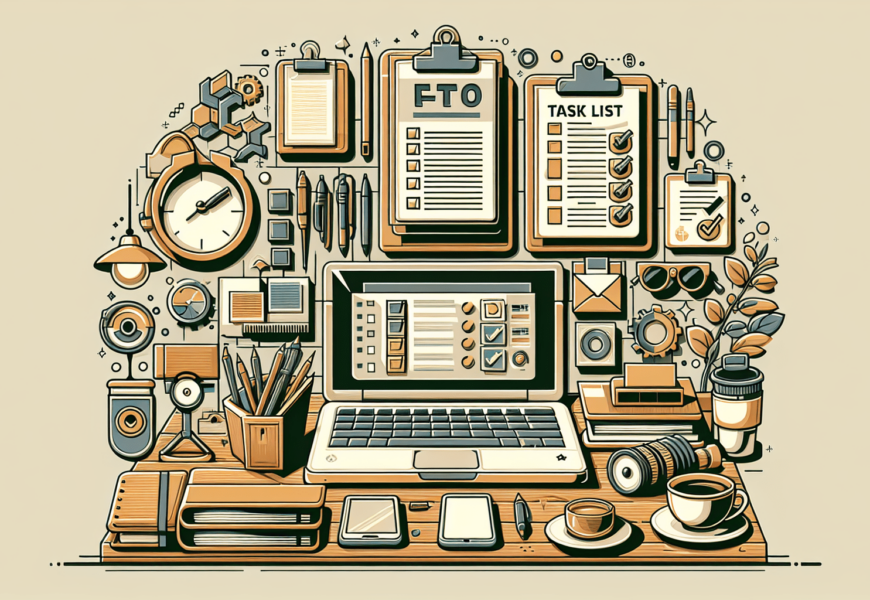You’re a dedicated freelancer, focused on meeting deadlines and delivering top-notch work. But sometimes, managing multiple tasks can become overwhelming. That’s why it’s crucial to adopt effective task management techniques to stay organized and boost productivity. In this article, we’ll explore the most popular strategies used by freelancers to conquer their to-do lists and thrive in their freelance careers. Whether you’re a seasoned freelancer or just starting out, these techniques will help you stay on track and accomplish your goals with ease.
Understanding Task Management
The concept of task management
Task management refers to the process of planning, organizing, and executing tasks in order to achieve specific goals and objectives. In a fast-paced and dynamic freelancing environment, effective task management is crucial for freelancers to stay productive and meet client deadlines. It involves prioritizing tasks, allocating resources, and monitoring progress. By implementing task management techniques, freelancers can streamline their workflow, reduce stress, and improve overall efficiency.
The importance of task management for freelancers
Task management is especially important for freelancers who often juggle multiple projects and clients simultaneously. Without proper task management, freelancers risk missing deadlines, delivering subpar work, and disappointing clients. By effectively managing tasks, freelancers can stay organized, maintain clarity on project objectives and requirements, and ensure timely completion and delivery of high-quality work. Moreover, task management enables freelancers to optimize their time, identify and address bottlenecks, and achieve a healthy work-life balance.
Time Blocking Technique
What is the time blocking technique
The time blocking technique is a task management method that involves scheduling specific blocks of time for different tasks and activities. By allocating fixed time slots for each task, freelancers can better manage their time, minimize distractions, and improve focus and productivity. This technique allows freelancers to effectively prioritize their work, ensuring that important tasks are given adequate attention while avoiding procrastination.
How freelancers can implement the time blocking technique
To implement the time blocking technique, freelancers can start by identifying their most important and time-sensitive tasks. They can then allocate specific time blocks in their schedules dedicated solely to those tasks. This means setting aside uninterrupted time for focused work, eliminating unnecessary distractions, and committing to completing the task within the allocated time. In addition, freelancers can also schedule blocks of time for breaks, administrative tasks, and personal activities to ensure a well-rounded and balanced workday.
Advantages of the time blocking technique for freelancers
The time blocking technique offers several advantages for freelancers. Firstly, it helps in improving focus and concentration by eliminating multitasking and allowing for deep work. By dedicating focused time blocks to specific tasks, freelancers can achieve a state of flow and maximize their productivity. Secondly, it promotes effective time management by providing a clear overview of how time is being allocated and utilized. This enables freelancers to assess their workload, identify potential gaps or overlaps, and make necessary adjustments to optimize their schedule. Finally, the time blocking technique allows freelancers to set realistic expectations with clients and manage their workload more efficiently, leading to increased client satisfaction and improved professional reputation.
The Eisenhower Box Technique
Overview of the Eisenhower Box Technique
The Eisenhower Box Technique, also known as the Eisenhower Matrix or the Urgent-Important Matrix, is a task management tool that helps freelancers prioritize tasks based on their urgency and importance. It was popularized by former U.S. President Dwight D. Eisenhower, who was known for his ability to effectively manage his time and responsibilities. The technique categorizes tasks into four quadrants:
- Urgent and Important: Tasks that require immediate attention and have significant impact on project success or client satisfaction.
- Important but Not Urgent: Tasks that are important for long-term goals and success, but do not require immediate attention.
- Urgent but Not Important: Tasks that demand immediate attention, but have less impact on long-term goals or can be delegated to others.
- Not Urgent and Not Important: Tasks that neither require immediate attention nor significantly contribute to long-term goals.
Applying Eisenhower Box in freelance work
Freelancers can apply the Eisenhower Box technique to effectively prioritize their tasks and manage their workload. They can start by creating a list of all their pending tasks and categorizing them into the four quadrants of the matrix. This helps freelancers gain clarity on which tasks are urgent and important, allowing them to focus on those that require immediate attention. By addressing urgent and important tasks first, freelancers can ensure they meet client deadlines and deliver high-quality work. The technique also encourages freelancers to delegate or eliminate tasks that are not important, freeing up valuable time and resources for more important work.
Benefits of the Eisenhower Box for freelancers
The Eisenhower Box technique offers several benefits for freelancers. Firstly, it helps in prioritizing tasks and allocating time and resources to those that truly matter. By differentiating between urgent and important tasks, freelancers can avoid the trap of constantly reacting to urgent but low-value tasks that may hinder their progress on important and higher-value work. Secondly, the technique promotes effective decision-making by providing a framework for evaluating tasks based on their relative importance and urgency. Freelancers can make informed choices about where to invest their time and effort, leading to better outcomes and increased productivity. Finally, the Eisenhower Box technique enhances freelancers’ ability to manage their time and workload, resulting in improved work-life balance and reduced stress.
Kanban Board Technique
Defining Kanban Board technique
The Kanban Board technique is a visual task management method that originated from the Toyota Production System and has been widely adapted for various industries, including freelancing. A Kanban board typically consists of three columns: “To Do,” “In Progress,” and “Done.” Tasks are represented as cards or sticky notes and are moved across the columns as their status changes. By visualizing the workflow and progress of tasks, freelancers can effectively track and manage their work.
Steps to using Kanban Board in freelance tasks
Freelancers can implement the Kanban Board technique by following a few simple steps. Firstly, they need to create a physical or digital Kanban board. They can use a whiteboard or a project management tool that supports Kanban boards. Secondly, they should identify and list all their pending tasks in the “To Do” column. Thirdly, freelancers can assign priority or due dates to each task and move them to the appropriate column based on their progress. As they work on a task, they can move it from the “To Do” column to the “In Progress” column, and eventually to the “Done” column when it is completed. Regularly reviewing the Kanban board helps freelancers stay organized, prioritize tasks, and identify potential bottlenecks or delays.
Why freelancers should consider the Kanban Board technique
The Kanban Board technique provides numerous benefits for freelancers. Firstly, it enhances visibility and transparency, allowing freelancers to have a clear overview of their workload, deadlines, and progress. By visualizing their tasks, freelancers can easily identify which tasks need immediate attention and prioritize accordingly. Secondly, the technique promotes collaboration and communication, particularly when used in a team setting. Team members can see the status and progress of each task, facilitating coordination and effective project management. Additionally, the Kanban Board technique encourages continuous improvement by highlighting areas for optimization or process refinement. Freelancers can identify recurring patterns or bottlenecks and make necessary adjustments to increase efficiency and productivity.
Pomodoro Technique
Understanding the Pomodoro technique
The Pomodoro technique is a time management method developed by Francesco Cirillo in the late 1980s. It involves breaking work into intervals called “Pomodoros,” typically lasting 25 minutes, followed by short breaks of 5 minutes. After completing a set of four Pomodoros, freelancers can take a longer break of 15-30 minutes. This technique aims to improve focus, productivity, and mental agility by leveraging the benefits of both focused work and regular breaks.
Application of Pomodoro in freelance work
Freelancers can apply the Pomodoro technique to manage their time and concentration effectively. By setting a timer for 25 minutes, freelancers can work with undivided attention and eliminate distractions during this focused period. Once the timer goes off, they can take a 5-minute break to relax, stretch, or engage in a different activity before resuming the next Pomodoro. After completing four Pomodoros, freelancers can reward themselves with a longer break to recharge.
The effectiveness of Pomodoro for freelancers
The Pomodoro technique offers several benefits for freelancers. Firstly, it improves productivity by breaking down work into manageable chunks and eliminating the overwhelming feeling of long, uninterrupted work sessions. The focused bursts of work followed by short breaks help maintain mental freshness and prevent burnout. Secondly, the technique enhances time management by providing a structured framework for organizing work and managing distractions. Freelancers can allocate specific Pomodoros to different tasks, ensuring a balanced distribution of effort and progress. Finally, the Pomodoro technique promotes work-life balance by encouraging regular breaks and minimizing the risk of excessive work hours. It helps freelancers maintain their physical and mental well-being while staying productive throughout the day.
Getting Things Done (GTD) Method
Explaining the GTD method
The Getting Things Done (GTD) method, developed by productivity consultant David Allen, is a comprehensive approach to task management and personal productivity. The GTD method emphasizes capturing, clarifying, organizing, and reviewing tasks and commitments to achieve a state of “mind like water” – a calm and focused mental state.
Implementing GTD for freelance jobs
Freelancers can implement the GTD method for effective task management. It starts with capturing all tasks, ideas, and commitments in a trusted system such as a to-do list or digital task management tool. Once captured, freelancers can clarify the tasks by defining the desired outcome and identifying the next actionable step. They can then organize the tasks into appropriate categories or projects, ensuring a clear structure and easy retrievability. Regularly reviewing the task list and reassessing priorities helps freelancers stay on top of their workload and make necessary adjustments. By adopting the GTD method, freelancers can minimize mental clutter, reduce stress, and ensure effective execution of their tasks.
The impact of GTD on freelance productivity
The GTD method has a profound impact on freelance productivity. Firstly, it helps freelancers achieve a state of clarity and focus by externalizing and organizing their to-dos. By capturing tasks outside their minds, freelancers can free up mental space and reduce cognitive load. This enables them to concentrate better, enhance decision-making, and stay present in the task at hand. Secondly, the GTD method promotes a proactive and systematic approach to task management. By regularly reviewing and reflecting on their workload, freelancers can better manage their priorities, make informed choices, and avoid last-minute rushes. The method also fosters a sense of control and mastery over one’s work, leading to increased confidence and motivation.







